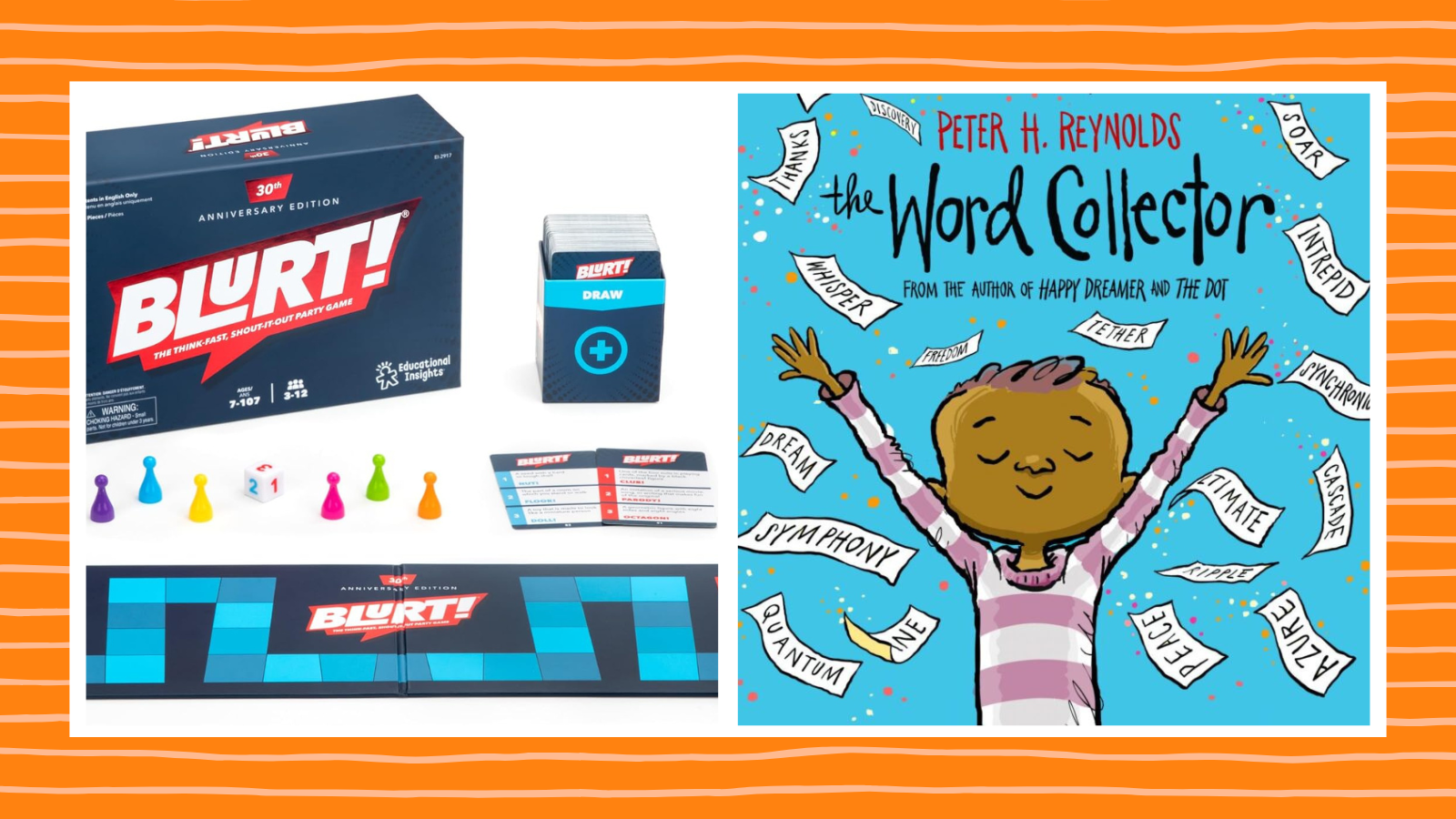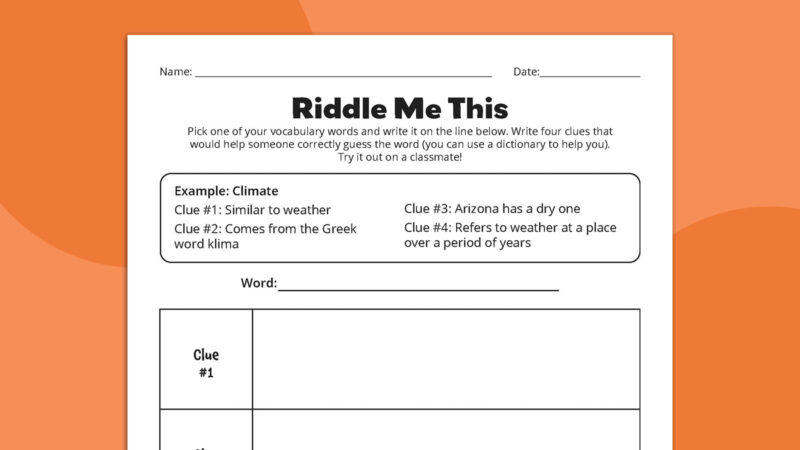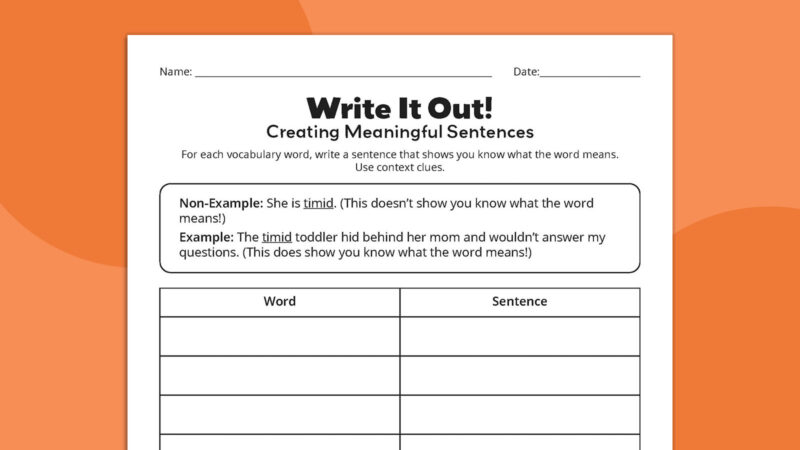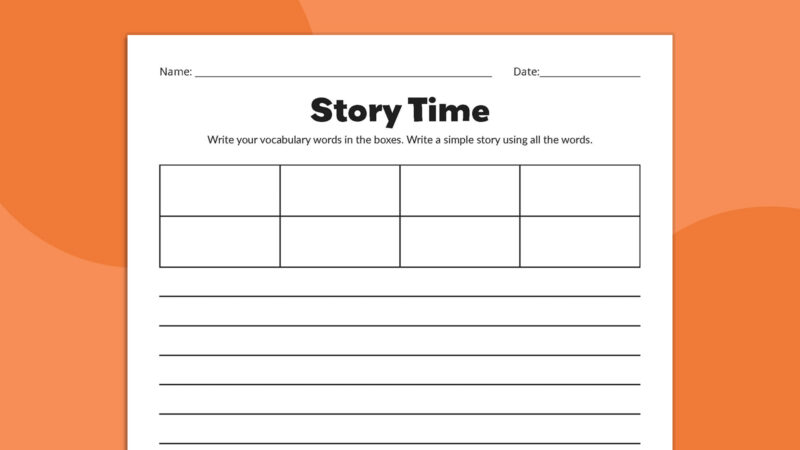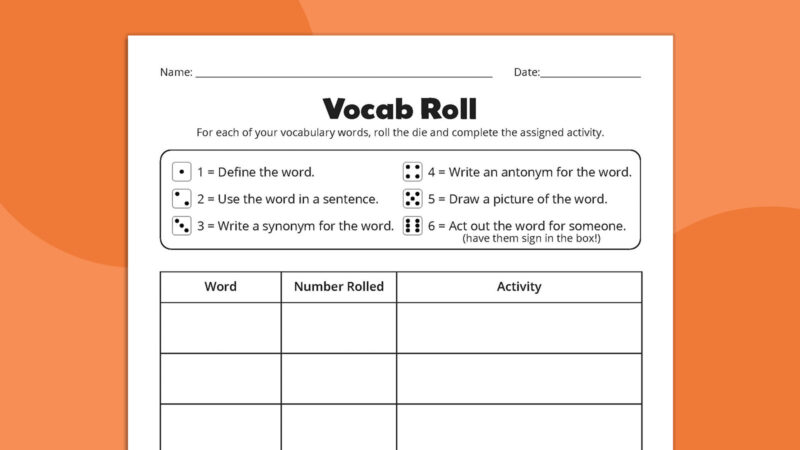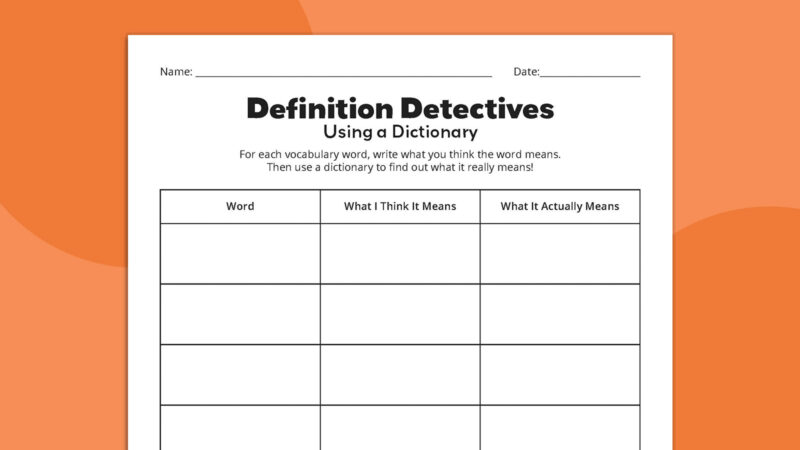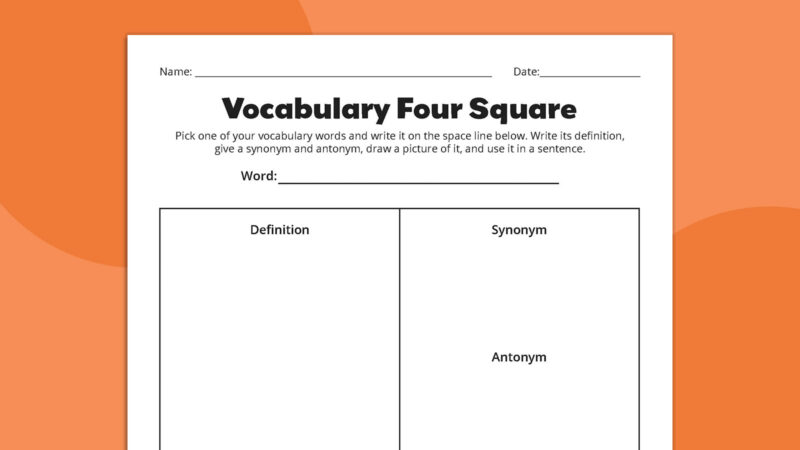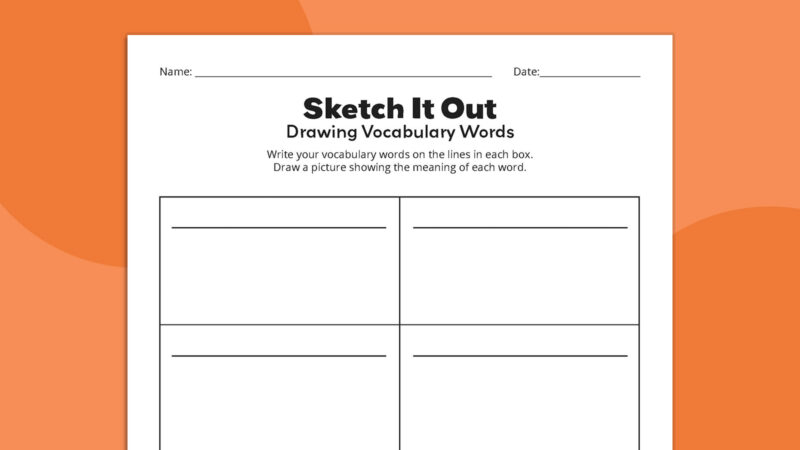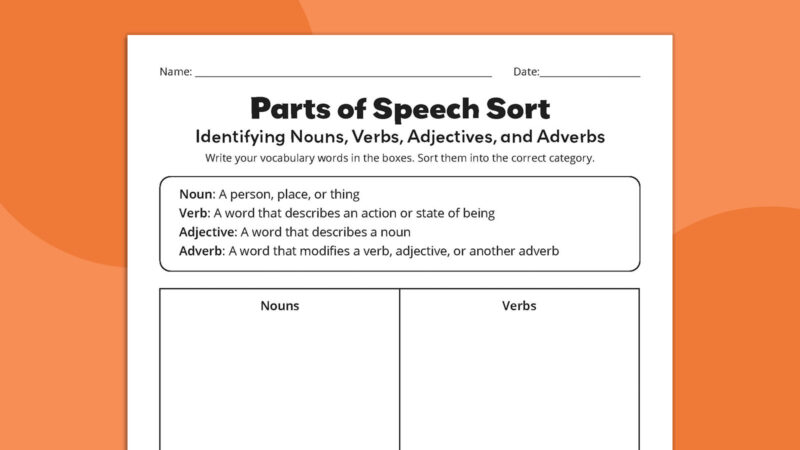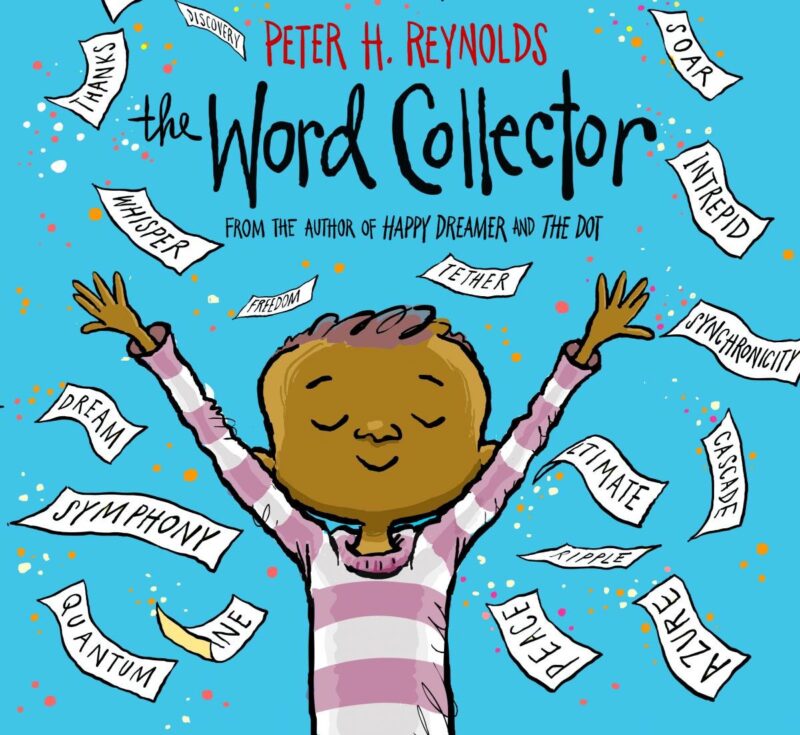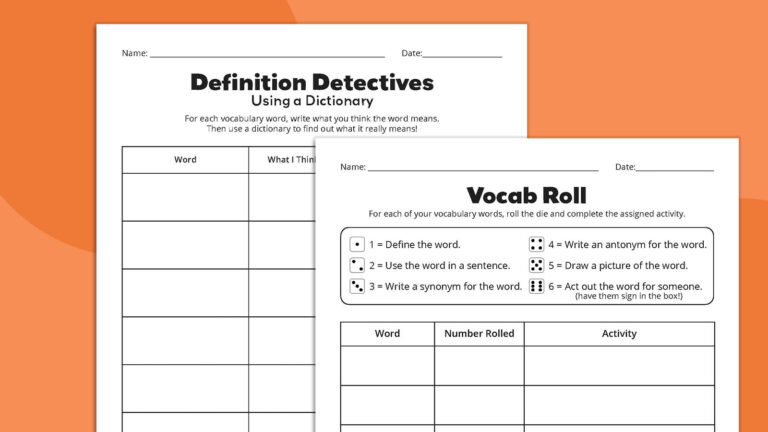Learning new words is like adding to your writing toolbox. The more tools available, the more interesting and engaging your writing becomes. Check out these fun and engaging vocabulary activities for kids in grades K-12, and supply your students with the tools they need to build their wordsmith skills.

FREE WORKSHEETS
Vocabulary Activities Worksheets
Grab a set of free printable vocab worksheets to go along with 8 of the activities below!
Jump to:
- Vocabulary Games for Kids
- Vocabulary Writing Activities
- More Fun Vocabulary Activities
- General Vocabulary Building Activities
Vocabulary Games for Kids
Hot Seat
Here’s one fun way to use Riddle-Me-This clues! Divide the class into two teams. The first team chooses one student sits in the “hot seat” at the front of the classroom. Then, the teacher shows their teammates the target word for that round and sets a timer for 1 minute. The team gives clues to the player, who must guess the correct term before the time is up. Switch teams, and go for round 2! Optional: The player must spell the word correctly to earn the point.
Taboo
This is similar to Hot Seat, but with a twist! You’ll need to create the cards for this one in advance: Write each term on your list on a separate card. On each card, also include several words students are NOT allowed to use in the game. For instance, if the word is “alligator,” you might list the taboo words “teeth,” “Florida,” and “swamp.” If players use any of these words when trying to get their teammate to say the target term, they automatically lose the point!
Vocabulary Matchup
Create a pair of cards for each of your vocab terms. One should show the word itself, the other the definition. Mix up the cards and pass them out, one to each student. Their job is to talk to other students until they find the person who has their match. Once everyone is finished, verify their answers, then collect the cards, mix them up, and pass them out again for another round.
Word Pop!
In a bag or bin (bonus points if it’s popcorn-themed!), place cards with the definitions, synonyms, and antonyms of your vocabulary words. Mix in one or two cards that just say POP! Kids take turns drawing a card and naming the vocabulary word that it describe. If they get it right, they keep the card—if not, it goes back into the bag. Be careful, though: If you get the POP! card, you forfeit all your cards!
Vocab Pictionary
Just like the beloved classic, but the words are vocabulary words! Teams send one player up to draw the word on the card they draw (prepare these in advance), and their teammates have 60 seconds to guess it. This one is always a classroom hit!
Charades
Here’s another classic game that’s perfect for vocabulary word practice. Your students will have a blast trying to act out the words for their teammates to guess. You can also have several students prepare brief skits that demonstrate the terms, then see if their classmates can figure them out.
A to Z Vocabulary
This vocabulary game is fun and challenging, and it can be played by kids of any age. Have kids work in teams. One player on each team, the scribe, writes the letters A to Z down left side of a page. Then show the first vocabulary word and set a timer for three minutes. Teams work together to come up with words that relate to the vocab term (synonyms, antonyms, examples, etc.). When time is up, teams share their words and tally up their points. (For a fun twist, assign points to each letter, as in Scrabble, with trickier letters earning more points.)
Vocabulary Jeopardy
Create a Jeopardy style board, with categories including Definition, Synonym, Antonym, and Sentence. Then, make set of cards for your vocab word list, and lay them face down in each category. Kids choose a category and dollar amount, then flip the card to see the vocab word. They must then define the word, offer a synonym or antonym, or use it in a sentence, whichever fits the category.
Vocabulary Writing Activities
Write the Room
Add a fun twist to Write It Out by posting the vocabulary words on sticky notes scattered around your classroom. Number them, and have kid number their worksheet too. Then, groups circulate the room, looking for the sticky notes. When they find one, they write the word by the correct number, then write their sentences.
Vocab RAFT
Writing a story using vocab words is a perennial favorite, but the RAFT method gives it a new twist. Give each student a Role (the point of view from which they’ll tell the story), an Audience, a Format, and a Topic. For instance, they might be an astronaut (Role) writing a postcard (Format) to their friends back home (Audience) about what they’ve seen on Mars (Topic). RAFTs are especially great for kids who claim they don’t know what to write about.
Vocabulary Journal Prompts
Provide kids with a journal prompt, and require them to use each of their vocab terms at least once in their response. Need writing prompt ideas? We’ve got you covered (see even more here)!
- 40 Gratitude Journal Prompts for Kids
- 101 Best Writing Prompts for Middle School
- 100 Argumentative Writing Prompts
- 150 Picture Writing Prompts
Social Vocabulary
This is one of those vocabulary activities kids will want to do over and over again! Assign each student a word and have them create a faux Facebook, Instagram, or other social media page for it. They can draw them by hand, or use an online tool like Fakebook. Post the images to a shared Google slideshow so other students can use them for review.
Write an acrostic poem for each vocab term, using the letters to determine the first word in each line. This can get really challenging when words are longer! Find tips on writing acrostics here.
More Fun Vocabulary Activities
Word Maps
Creating word maps from vocabulary words encourages students to find the relationships between the vocabulary word and other words. Have them include words, pictures, examples, real-world connections, definitions, descriptive words, etc.
Vocabulary Gallery Walk
Hang six to eight large sheets of chart paper in various places around the room. On each sheet, write one vocabulary word. Have students work in small groups, rotating between stations. At each station, ask students to come up with a different, original way to use each word, adding it to the chart. Continue the activity until all students have visited every station, then review them all together.
Graffiti Wall
Think of a vocabulary graffiti wall like a collaborative word wall. In the classroom, post the words on the wall and have kids add sticky notes to illustrate the term (they can use words or pictures). Online, try a tool like Padlet or Google Slides.
Vocabulary Flash Cards
Simple but effective! Give kids a stack of notecards, and have them write one vocab word on each. Then, flip the cards over and ask them to write the definition, draw a picture, or make any other helpful notes they can use when they review the word independently or with friends.
Graphic Organizers
Take illustrations one step further with graphic organizers! Here’s how they work. (Tip: Want to go digital? Have kids make a slideshow, one slide per word. They can include the same information, but instead of drawing a picture, have them find one online that illustrates the concept.)
Vocabulary Character Match
This is a terrific way to practice vocab words pulled from books you’re reading. Ask students to use various words to describe the different characters in the book and their feelings, thoughts, and actions.
Word of the Day
Give really important terms the attention they deserve. Choose a new vocab word each day, then explore it in depth and make an effort to use it in class the whole day long.
Golden Word Club
Post a list of target vocab words. If a student uses one of the words in class (outside of vocabulary activities), they become a member of the Golden Word Club! You can have them sign their name on a wall in the classroom or award a badge online. You could even develop this into a reward system for homework passes or extra credit.
Shades of Meaning
This is a cool idea for exploring synonyms and the slight differences that make words unique. Ask for paint sample strips at your local hardware store. Write a vocab word at the top of each. Then, have students write similar words (synonyms) on each chip. Make notes about the subtle shades off difference between the various words. (Get more paint chip teaching ideas here.)
General Vocabulary Building Activities
New Word Journal
Give kids a small notebook they can carry around with them. Whenever they encounter a word they don’t know, they write it down in their journal on a new page. They’ll find new words on signs and menus, in conversations or on tv shows, or while surfing the web! When they have time, they can look up the definition and write it in.
Sticky Words
When students read a new book from your classroom library, have them keep a pad of sticky notes handy. As they encounter words they don’t know, they write each one on a sticky note, then look up the definition and write that too. Stick each note to the inside covers of the book, so others who read the book can use it as a glossary!
Vocab Show and Tell
Think of this like everyone’s favorite preschool activity, but for words! Choose a few students each week to “bring” a new word to show the class. Have them choose the word in advance and share it with you to make sure it’s appropriate and they truly understand it. Then, each student brings and presents something that “shows” and “tells” the word and its meaning. Example: If the word is “fuzzy,” a student might bring their favorite stuffed animal. For “delicious,” they could bring a favorite treat to share with the class.
